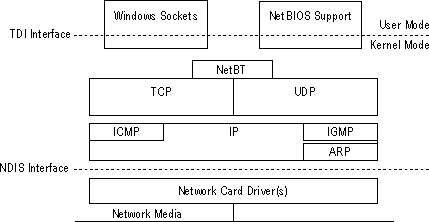
TCP/IP is the primary protocol of the Internet and intranets (networks that connect enterprise-wide local area networks). You can communicate with computers running under Windows NT, with devices that use other Microsoft networking products, and with computers running under non-Microsoft operating systems using TCP/IP (such as UNIX computers).
The TCP/IP protocol suite in Windows NT Server and Windows NT Workstation was completely redesigned beginning with Windows NT version 3.5. It is a high-performance, portable, 32-bit implementation of the industry-standard TCP/IP protocol suite and is easy to administer. Microsoft 32-bit TCP/IP for Windows NT provides support for standard TCP/IP features including:
The TCP/IP protocol suite for Windows NT Server and Windows NT Workstation is comprised of:
The Windows NT – based networking services include, but are not limited to, the following:
The following figure illustrates the Windows NT TCP/IP architecture model and shows the core protocol elements and the interfaces between protocol elements and services.

Figure 6.1 The Windows NT TCP/IP Architecture Model
Note
Specifications and programming information for Microsoft 32-bit TCP/IP are included in the Windows NT Device Driver Kit (DDK). The Transport Driver Interface (TDI) and the Network Driver Interface Specification (NDIS) are public specifications available from Microsoft.